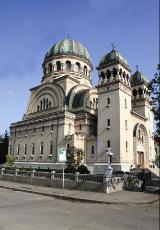 The church is one of the most representative architectural monuments of the city, built between 1932 and 1937. On its place used to be a former baroque church, built between 1799 and 1803. The old church had served the famous scholar Petru Bran, who was the first teacher of Romanian language in Satu Mare and the author of the first Romanian book printed in the city. Within, the persons serving in the old church are Ioane Marcu, one of the greatest Romanian scholars, Constantin Lucaciu and Dr. Vasile Lucaciu, militants for national, political and cultural emancipation. The old church became too small, therefore, “The Association of Romanians from Satu Mare” was established to
The church is one of the most representative architectural monuments of the city, built between 1932 and 1937. On its place used to be a former baroque church, built between 1799 and 1803. The old church had served the famous scholar Petru Bran, who was the first teacher of Romanian language in Satu Mare and the author of the first Romanian book printed in the city. Within, the persons serving in the old church are Ioane Marcu, one of the greatest Romanian scholars, Constantin Lucaciu and Dr. Vasile Lucaciu, militants for national, political and cultural emancipation. The old church became too small, therefore, “The Association of Romanians from Satu Mare” was established to raise funds for the building of the new church, in 1926. The demolition of the old church was started in 1932, the last service being celebrated on the 14th of June. After that, the sacraments were transferred in a procession to the Roman Catholic church “Calvaria” where the Romanians held the masses until 1937, when the building of the new church was finished. The project of the new church was made by the
raise funds for the building of the new church, in 1926. The demolition of the old church was started in 1932, the last service being celebrated on the 14th of June. After that, the sacraments were transferred in a procession to the Roman Catholic church “Calvaria” where the Romanians held the masses until 1937, when the building of the new church was finished. The project of the new church was made by the  architect Victor Şmighelski, while the execution was conducted by the architect G. P. Liteanu. The edifice is in accordance with the Byzantine canons being enriched artistically with the traditional Romanian architectural elements. The spatial organization maintains the classic structure with the narthex, the pronaos, the nave and the altar. The building is dominated by the dome, erected over the walls of the nave through an intermediary level. The dome has 14 m in width and 40 m in height. According to the architect, the illumination system is a technical innovation applied for the first time to such a big building. The light enters through the large arcades of the barrel of the dome, generating a diffuse light that intensifies the atmosphere of calm and peace. On the outside, the columns have sculpted capitals, and the plinth resembles the shape of a decorative belt. The edifice is listed as a national monument. (DB).
architect Victor Şmighelski, while the execution was conducted by the architect G. P. Liteanu. The edifice is in accordance with the Byzantine canons being enriched artistically with the traditional Romanian architectural elements. The spatial organization maintains the classic structure with the narthex, the pronaos, the nave and the altar. The building is dominated by the dome, erected over the walls of the nave through an intermediary level. The dome has 14 m in width and 40 m in height. According to the architect, the illumination system is a technical innovation applied for the first time to such a big building. The light enters through the large arcades of the barrel of the dome, generating a diffuse light that intensifies the atmosphere of calm and peace. On the outside, the columns have sculpted capitals, and the plinth resembles the shape of a decorative belt. The edifice is listed as a national monument. (DB).References:
Lostun, Viorel, Biserica „Sfinţii Arhangheli Mihail şi Gavril”, din Satu Mare, în „Trepte vechi şi noi”, Oradea, 1980.
Idem, Istoricul parohiei (manuscris).